Benefits may loom largest in quality-of-life realms
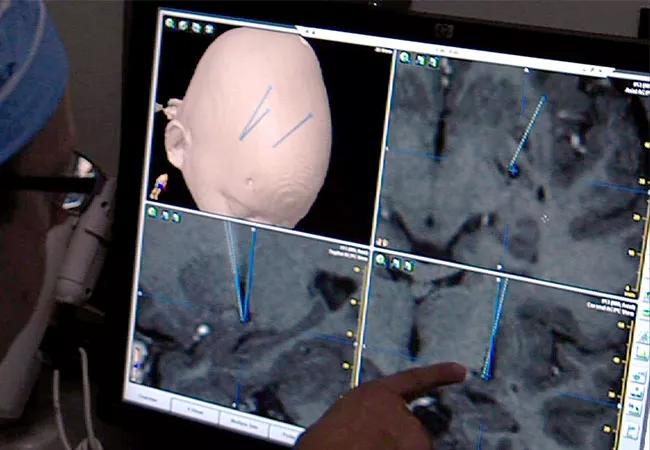
By Mohammed Aldosari, MD; Andre Machado, MD, PhD; and Hubert H. Fernandez, MD
Cleveland Clinic is a non-profit academic medical center. Advertising on our site helps support our mission. We do not endorse non-Cleveland Clinic products or services. Policy
Pharmacologic treatment of pediatric movement disorders is often unsatisfactory. Medications are frequently only partially effective in controlling abnormal movements, and side effects may be dose-limiting.
The past decade has witnessed growing interest in deep brain stimulation (DBS) for treating movement disorders in children. This interest stems from the established use of DBS as an option for various medically refractory movement disorders in adults, including Parkinson disease, dystonia, essential tremor and Tourette syndrome. DBS also is demonstrating efficacy for an expanding range of pharmacotherapy-resistant neurological and psychiatric disorders in adults.
Pediatric use of DBS is particularly promising since early treatment may have a significant impact in young patients, such as improving functional abilities, quality of life and social integration, as well as enabling completion of education and enhancing employment opportunities.
DBS has been shown to be highly effective for the treatment of medically refractory genetic primary dystonias and, in some cases, the near elimination of dystonic movements and dystonia-related disability. The success of DBS in these disorders has inspired its application to secondary dystonias, including those associated with cerebral palsy, stroke and neurodegenerative conditions.
Cerebral palsy is the most common nongenetic cause of secondary dystonia. About 10 to 15 percent of patients with cerebral palsy develop a dyskinetic or extrapyramidal movement disorder. The involuntary movements typically start during early infancy and may be slowly progressive. Affected patients frequently have severe motor disability despite normal or near-normal cognitive function.
Several case reports and series have been published about the therapeutic outcome of DBS in patients with dyskinetic/extrapyramidal cerebral palsy, reporting varying results. Although most reports show that the direct clinical benefit in reducing dystonic movements is less dramatic than the level of reduction observed in idiopathic dystonia, a moderate but clinically significant improvement in dyskinesia in patients with dyskinetic/extrapyramidal cerebral palsy has been shown after DBS surgery. More importantly, quality of life, functional abilities, pain and caregiver burden can be considerably improved after DBS, even without clinically measurable changes in dystonia severity.
Notably, traditional dystonia rating scales do a poor job of distinguishing small but meaningful improvements in levels of function (such as wheelchair control and activities of daily living) that are important in this population of patients. Many of these patients and their families perceive their improvement after DBS in quite a different way than is reflected by clinical rating scales, and small changes in function or mobility seem to bring essential benefit for these patients. There are reports of improvement of severe oromandibular dystonia with DBS, allowing children to speak and eat for the first time.
Other causes of secondary dystonia — including those associated with neurodegeneration with brain iron accumulation, glutaric aciduria, mitochondrial cytopathies, autoimmune inflammatory disease of the basal ganglia, Lesch-Nyhan syndrome, and secondary dystonias of unknown etiologies — have shown similarly promising responses to DBS.
Another promising application is the use of DBS in children and adolescents with medically refractory Tourette syndrome. Some patients with Tourette syndrome experience worsening symptoms associated with severe physical, emotional, social, academic and occupational difficulties. In some cases, surgical management might be the only remaining option. A growing body of experience indicates that tics uniformly improve after DBS. Moreover, the neuropsychological and psychiatric comorbidities frequently improve with DBS.
Clinical outcomes have been shown to be dependent on precise placement of DBS leads. Pediatric patients undergoing DBS present unique technical challenges.
In adults, the traditional method for DBS lead implantation involves physiological localization while patients are awake. Localization methods have included microelectrode recording and/or intraoperative test stimulation to assess for therapeutic effects and stimulation-induced adverse events. Since these methods often require the patient to be calm and cooperative over several hours of testing, they are not appropriate for most children.
Consequently, real-time interventional MRI guidance has been developed for implanting DBS leads. Interventional MRI allows as-needed intraoperative imaging. Use of interventional MRI to guide placement of DBS leads in children has been associated with highly accurate electrode placement, which results in improved clinical outcomes.
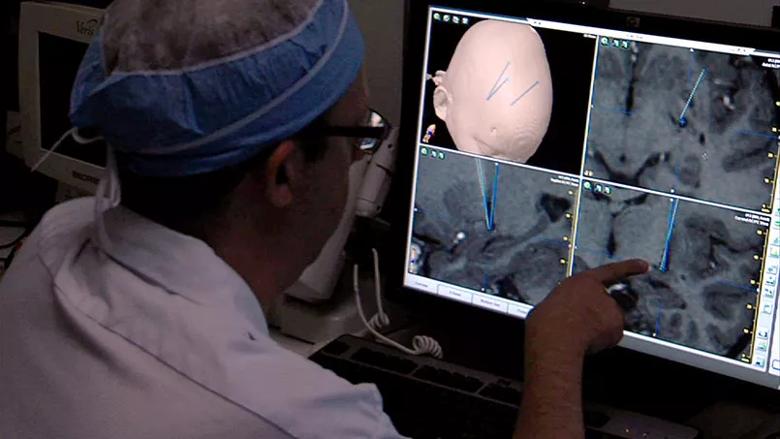
Real-time interventional MRI during pediatric DBS surgery at Cleveland Clinic enables surgeons to assess electrode placement.
Cleveland Clinic was one of the first U.S. centers to implement intraoperative MRI in DBS surgery, including in children.
In our experience, patients can stay with their parents in an induction room until just before general anesthesia is started, which may reduce the anxiety associated with entering the operating room. Once the surgical team devises a plan, DBS leads or temporary MRI-compatible probes are inserted into the targeted brain areas and new MRIs are obtained. The final location for the leads is then determined. The pulse generator can also be implanted under general anesthesia. Postoperative device programming is performed by specialized professionals with extensive experience in DBS and movement disorders.
The application of DBS to the pediatric population is evolving rapidly. DBS is expected to become an early and effective treatment option for an expanding range of pediatric movement disorders. Detailed studies of outcomes to improve patient selection criteria, timing of surgery, lead placement targets and operative techniques are urgently needed.
The development of more-sensitive rating scales to assess important functional changes will help in evaluating the clinically meaningful benefits of DBS, especially in children with secondary dystonias. Innovative operative technologies are also expected to improve outcomes and reduce potential surgical complications.
DiFrancesco MF, Halpern CH, Hurtig HH, et al. Pediatric indications for deep brain stimulation. Childs Nerv Syst. 2012;28(10):1701-1714
Keen JR, Przekop A, Olaya JE, et al. Deep brain stimulation for the treatment of childhood dystonic cerebral palsy. J Neurosurg Pediatr. 2014;14(6):585-593
Israelashvili M, Loewenstern Y, Bar-Gad I. Abnormal neuronal activity in Tourette syndrome and its modulation using deep brain stimulation. J Neurophysiol. 2015;114(1):6-20
Starr PA, Markun lC, Larson PS, et al. Interventional MRI-guided deep brain stimulation in pediatric dystonia: first experience with the ClearPoint system. J Neurosurg Pediatr. 2014;14(4):400-408.
Dr. Aldosari is a staff pediatric neurologist and pediatric movement disorder specialist with Cleveland Clinic’s pediatric neurosciences program.
Dr. Machado is Chairman of Cleveland Clinic’s Neurological Institute and Director of its Center for Neurological Restoration e.
Dr. Fernandez is Section Head of Movement Disorders in Cleveland Clinic’s Center for Neurological Restoration.

Q&A with Brain Trauma Foundation guideline architect Gregory Hawryluk, MD, PhD

Q&A with newly arrived autoimmune neurology specialist Amy Kunchok, MD
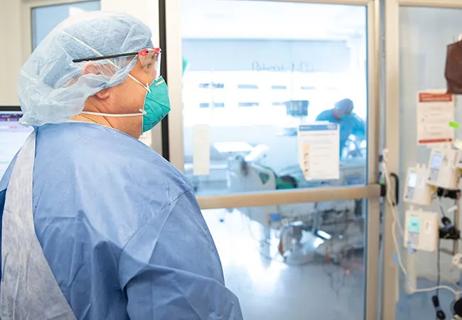
A neurocritical care specialist shares what’s spurring growth of this new evaluation approach

Focused ultrasound offers a newer alternative to deep brain stimulation

Prehabilitation can help improve outcomes after spine surgery

Get ready for central vein sign and optical coherence tomography
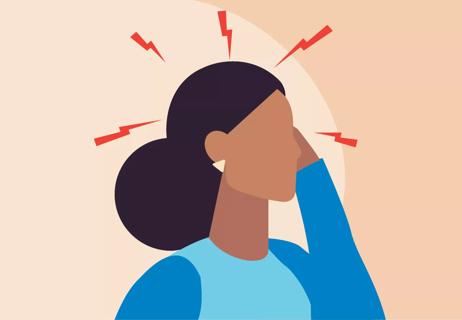
How these new drugs fit into practice two years out from their first approvals
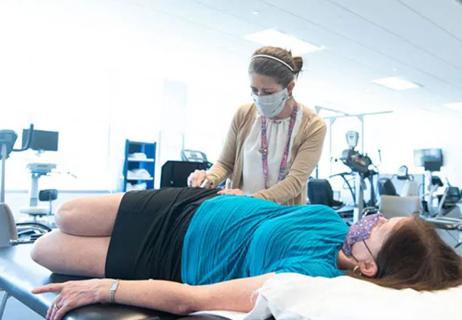
A conversation on the state of physiatry with the AAPM&R’s Vice President